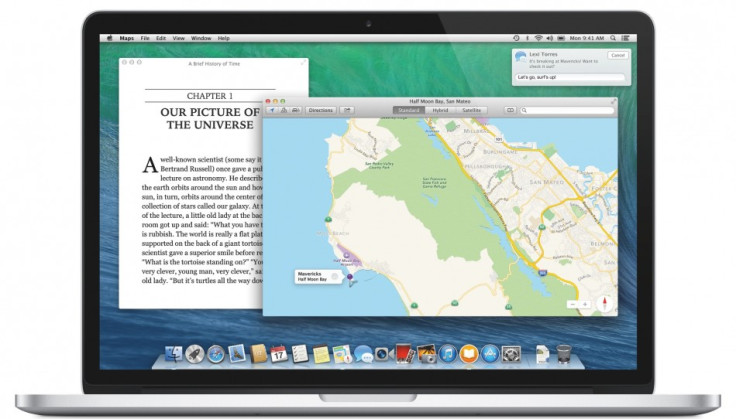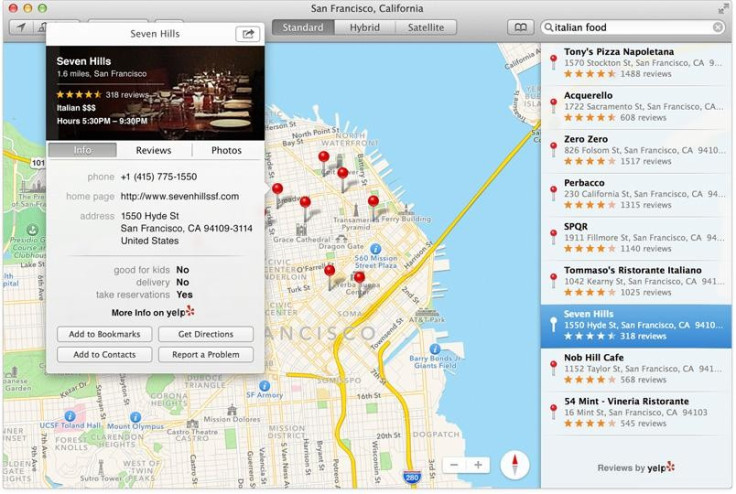Apple OS X 10.9 Mavericks: How to Download and Install
Apple's latest desktop operating system, OS X 10.9 Mavericks will be available for free from the Mac App Store; below is our guide on how to make sure your Mac is compatible with Mavericks, and how to prepare for the update.

Compatibility
OS X Mavericks requires your Mac to be powered by a 64-bit Intel processor, have at least 8GB of free disk space, and be already running either OS X Lion or Mountain Lion.
What this means, is that the following Mac computers can be upgraded to Mavericks:
- iMac (mid-2007 or later)
- MacBook (13in aluminium from late 2008, or 13in plastic model from early 2009 or later)
- MacBook Pro (13in, mid-2009 or later), (15in, late 2007 or later), (17in, late 2007 or later)
- MacBook Air (late 2008 or later)
- Mac Mini (early 2009 or later)
- Mac Pro (early 2008 or later)
In plain English, if your Mac is already running last year's OS X Mountain Lion or Lion, then it will also be capable of running Mavericks, too.
Getting Up To Date
Before heading to the App Store an downloading Mavericks, you should make sure your computer and every app on it is fully up to date. Updating the operating system without running the newest version of every application could make apps unstable or unusable after the OS has been installed.
For Apple's own applications, or anything installed from the App Store, updating is simple: open the App Store application, click the Updates tab, then click Update All.
Third party applications downloaded elsewhere will require more work. Some will automatically check for updates every time you open them, so you should start by opening each app you use and see if the app suggests you update it. If this doesn't happen, you'll have to go to the developer's website and check manually for any updates recently released.
Don't panic too much if you can't be sure every app is up to date however, as if it's already working on Lion or Mountain Lion, then it should work in Mavericks without a problem - it's just good practice to update as much as you can before installing a new operating system.

System Maintenance
Before installing a shiny new operating system is a good time to perform some basic system maintenance. Open Apple's Disk Utility application, found by clicking Spotlight in the upper-right corner and typing out the app's name.
Click on your computer's hard drive on the left-hand column - it'll be called Macintosh HD by default - and then click Verify System Permissions on the right-hand side. This process could take a couple of second or several minutes depending on when it was last done, and how big the hard drive is.
If all is well, a green confirmation message will be displayed. If a red message is displayed, the app will suggest you click Restore Disk Permissions - do so, and let the app conduct the repair. Once fixed, a green message will appear. If another red message is displayed, then a trip to your local Apple Store would be advisable.
Next, delete any applications you no longer use by dragging their icons from the Applications folder and into the bin, and it's worth emptying the bin and downloads folder too of anything you no longer need. Remember you need to have at least 8GB of free disk space, so clearing aware unused apps and old downloads is always a good idea.
Back Up
Finally, you'll want to backup your Mac. Should anything go wrong during the update - or you accidentally install Mavericks as a fresh install - you can always restore your documents, music, apps and everything else from a backup.
Apple's Time Machine app makes backing up easy. Attach an external hard drive - one with a capacity larger than that of the Mac itself - and the computer will ask if you want to make the drive a Time Machine backup drive. Ensure the external drive is empty and click Ok.
Once set up, the Time Machine drive will appear as an icon on your desktop. Right click on this, then click Back Up Now. This may take some time if you've a lot of data on your Mac.
Once backed up, restart your Mac to ensure no apps or processes are running in the background, and no more updates are required.
Install Mavericks
Finally, you're ready to install OS X Mavericks.
Open the Mac App Store, search for or click on Mavericks and download it for free - or click on this link to be taken directly to the Mavericks page.
Once downloaded, simply tell the computer where you want Mavericks installed (the internal Macintosh HD, and not the external Time Machine backup drive), and the installation process will begin.
During installation, your Mac will restart at least once and the whole process will take around 15 to 20 minutes, depending on the machine you're updating.
Once complete, you can log back into your computer and Mavericks will be up and running.
Read More:
© Copyright IBTimes 2025. All rights reserved.






















